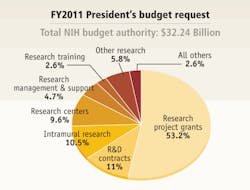BIOSCIENCE BUDGET/PUBLIC POLICY: Biomedical research funding up for 2011
It could have been worse. Just days before releasing his 2011 budget, President Obama signaled that tough choices would be made in discretionary spending. The science community held its collective breath, and in the end let out a sigh of relief. The 2011 R&D budget request of $147.7 billion moves the nation toward the long-term goal of creating R&D investment at 3% of the gross domestic product. Agencies key to biophotonics, including the National Institutes of Health (NIH) and the National Science Foundation (NSF), requested increases in their 2011 budgets. While these positive gains are welcomed, the fine print suggests growth will be modest.
"There is a sense that the agencies saw this coming and took it into account as they made their requests," says Patrick Clemins, director, R&D Budget and Policy Program at the American Association for the Advancement of Science. The tip-off to tighter funding appeared last summer when Peter Orszag, chief at the Office of Management and Budget, and John Holdren, head of the White House Office of Science and Technology Policy, circulated a memo to agency directors describing how to prioritize science and engineering needs for 2011.
In that guidance memo, Orszag and Holdren urged the agencies to describe how their programs can assist with economic recovery, job creation, and economic growth; promote innovative energy technologies; improve biomedical science and information technology to create healthier lives; and create technologies that ensure the safety of both soldiers and citizens.
The budget will likely change as it moves through Congress in the coming months but it will be a good test to see if science and health funding remain priorities for both the President and Capitol Hill.
Bio-optics highlights
NIH: $32.2 billion, an increase of $1 billion and 3% higher than 2010. "It's really not surprising that the budget would be flat next year," says Clemins. "There's a general consensus on the Hill that NIH got money in the last doubling and a nice chunk in the ARRA, so outside of a few targeted diseases, they [NIH] will have to pick and choose what they will be funding." (For a discussion of the impact of NIH ARRA funding view "Investing in Recovery and Discovery," produced by United for Medical Research, www.investingindiscovery.com/#/resources.)
More than $6 billion of the 2011 request would go to cancer research, an area Obama has identified as a priority. The money would:
- Initiate 30 new drug trials in 2011 to rapidly test the effectiveness of molecularly targeted cancer therapies,
- Double the number of novel compounds in Phase 1 – 3 clinical trials by 2016, and
- Strengthen the Early Detection and Diagnosis program for innovations such as microfluidic chip cell-sorting technology.
NNI: Another $1.7 billion would support the multi-agency National Nanotechnology Initiative (NNI). The NNI focuses on R&D that creates materials, devices, and systems that range from 1 to 100 nm. The National Institute of Biomedical Imaging and Bioengineering, which supports bio-optics research among others, requested $325.9 million, a 3.3% increase over the FY 2010 appropriations. In FY 2011, NIH estimates it will support a total of 37,001 research project grants, including 9,052 new and competing awards.
NSF: $7.4 billion, 8% increase over 2010 levels. Staff at the Biophotonics, Advanced Imaging, and Sensing for Human Health Program (BISH) expects little change in the program over the next year. BISH is part of the Chemical, Bioengineering, Environmental, and Transport Systems (CBET), which requested $169 million for 2011, a 7.8% increase. Within the Directorate for Biological Sciences (BIO) a request of $5.6 million would be used to partner with the Directorate for Mathematical and Physical Sciences to develop potentially transformative research projects that explore the intersection of biological and physical sciences.
About the Author

